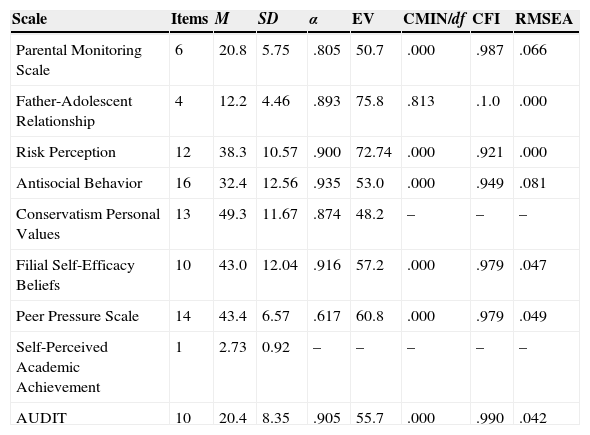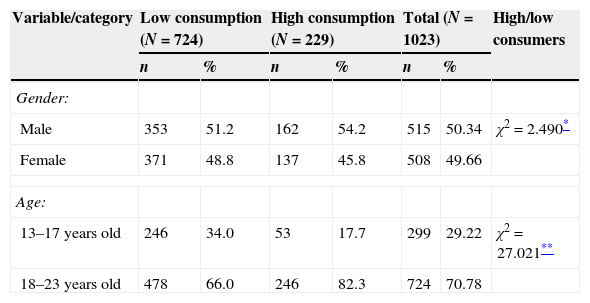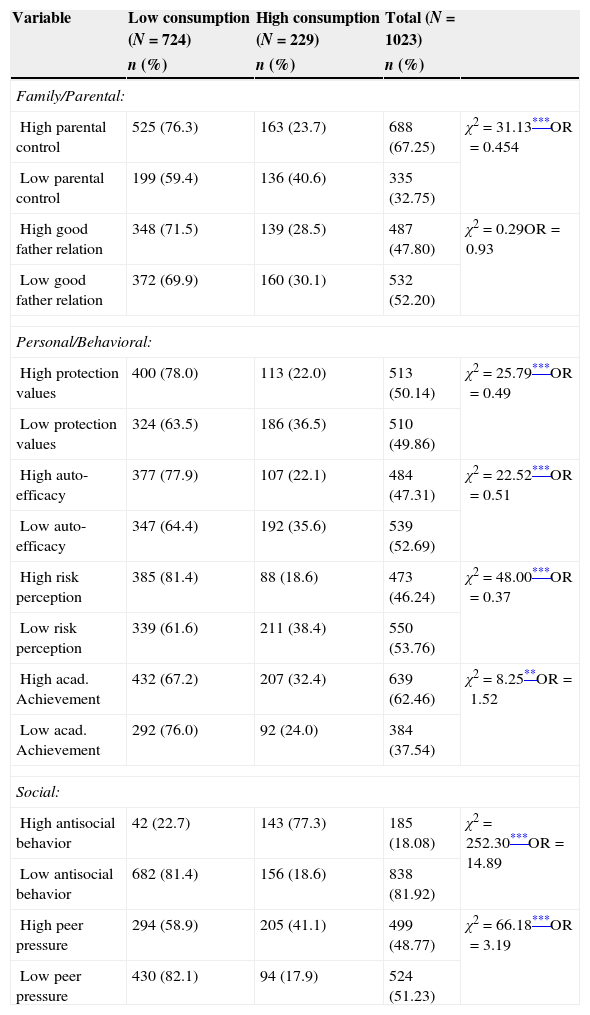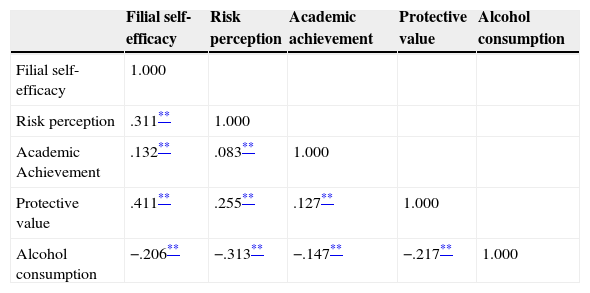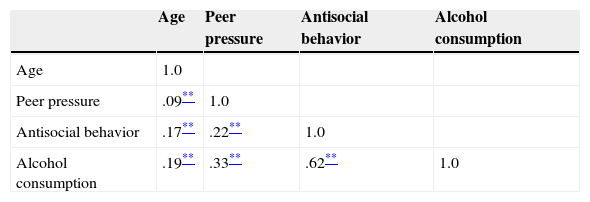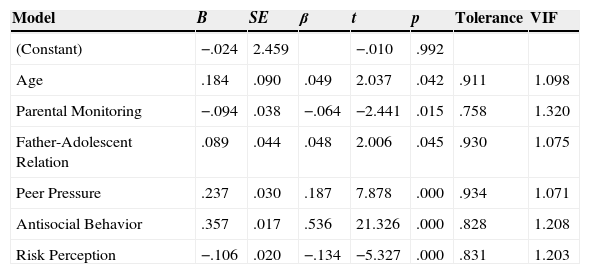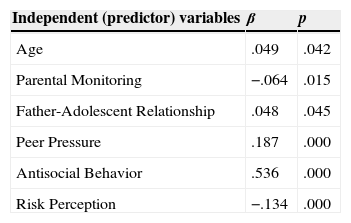Alcohol consumption prevalence in Bolivia is one of the highest in the region and the most degrading practices faced by the society. To apply the changes, social policy makers require objective, accurate, and complete information about the factors that could be considered both guards and risky. Hence, links between socio-demographics, family, personal/behavioral and social variables and youth alcohol use were analyzed in order to know their particular contributions to the explanation of drinking behavior. The study was carried out with a sample of 1,023 young students (13–23 years old), of both sexes (515 male and 508 female) recruited from local high schools and university initial undergraduate courses. The results showed strong ties between such variables and adolescent alcohol drinking behavior. The predictive model (linear regression model) fitted relatively well including variables such as age, parental monitoring, father–adolescent relationship, peer pressure, antisocial behavior and risk perception. Nevertheless, only social and parental variables proved a good fit with the empirical data when a theoretical model was proposed through a structured equation modeling. Although this model seems to be in good shape, it should be adjusted to a more comprehensive approach to a risk/protection conceptual framework.
La prevalencia de consumo de alcohol en Bolivia es una de las más altas en la región y una de las prácticas más degradantes que enfrenta la sociedad. Para realizar cambios duraderos, los formuladores de políticas sociales requieren información objetiva, exacta y completa sobre los factores de riesgo y protección de este problema. Por lo tanto, se analizaron los vínculos entre algunas variables socio-demográficas, familiares, personales y sociales con el comportamiento de consumo de alcohol. El estudio se realizó con una muestra de 1.023 jóvenes estudiantes (13 a 23 años de edad), de ambos sexos, reclutados de las escuelas secundarias locales y cursos universitarios iniciales. Los resultados mostraron fuertes lazos entre las variables analizadas y el consumo de alcohol de los adolescentes. El modelo predictivo ajustó relativamente bien incluyendo variables como la edad, control parental, relación padre-adolescente, presión de grupo, comportamiento antisocial y percepción de riesgo. Sin embargo, sólo las variables sociales y parentales demostraron un buen ajuste con los datos empíricos cuando se propuso un modelo teórico a través de ecuaciones estructurales. Aunque este modelo parece estar en buena forma, debería ser mejor ajustado de cara a un marco conceptual más integrado de las nociones de riesgo y protección.
Social policy makers are mainly interested in having a complete picture about the social, cultural, economic and psychological factors impacting vulnerable population sectors such as children, adolescents, women and elderly. Their work requires objective, precise and comprehensive information on those variables that actually enhance poverty and reduce well-being.
Alcohol abuse is one of the most well-known personal and social degrading practices; it surely impacts social and family relationships, job stability at the workplace, and endanger lives beyond the person who suffers from this condition. The toll it takes on a person's health and the emotional damage inflicted on others can be devastating and life threatening.
Alcohol abuse is of special concern in our society, due to direct association with major physical and mental health problems. Alcohol consumption prevalence in Bolivia is among the highest in the region; a recent nationwide study (N=14,166) has shown that life prevalence is 77.2%, annual prevalence is 59.1% and monthly prevalence 36.7%. A university study carried out by the Andean Community in cooperation with IACD and the Vice ministry of Social Defense has shown that life prevalence of alcohol use is 77.6%, annual alcohol consumption prevalence is 57.6% and monthly prevalence is 35.1%. Out of those that declared to have drunk during the last year (57.6%), 38.7% has shown to have risky or harmful consumption, and 17.3% has shown to have alcohol dependence.
These figures and recent alcohol related events: increased traffic accidents and increased public safety problems have sparked overall general concern in Bolivian society. Public opinion has forced the ruling government to adopt and pass several alcohol oriented laws to cope with the problem. The number of alcohol related deaths due to traffic accidents is extremely high and domestic violence figures show a close relationship with alcohol consumption.
Therefore, the study of determinant factors of alcohol abuse would provide policy makers with the conceptual bases to make decisions and develop preventive or remedial strategies oriented to reduce incidence of alcohol abuse in our societies lowering at the same time, the occurrence of all related problems.
A risk factor is a variable that significantly predicts whether an individual will develop disorder or disease. According to Mrazek and Haggerty (1994), to qualify as a risk factor, “a variable must be associated with an increased probability of disorder and must antedate the onset of disorder” (p. 129). “It is a measurable characterization of each subject in a specified population that precedes the outcome of interest and which can be used to divide the population into two groups: the high-risk and the low-risk groups that comprise the total population” (Kraemer, Kazdin, & Offord, 1997, p. 338).
Specialized literature (Donovan, 2004) identifies several factors or group of factors, variables or conditions highly correlated with alcohol abuse that could be generically defined as risk factors. The author points out at least five inclusive categories of risk factors: socio-demographic, family domain, peer domain, personality domain, and behavioral domain.
Socio-demographic risk factors. In the first category, we usually find variables such as gender, age, ethnic background, and socioeconomic status as potential risk factors for alcohol consumption onset. Information concerning many of these variables is derived primarily from descriptive epidemiology, using cross-sectional surveys that rely on aggregate analyses. Findings recommend careful interpretation of these indicators since isolated analysis could drive to limited conclusions. For example, studies intending to show differences between male and female concerning initiation of alcohol drinking were statistically non-significant (Beck, Shattuck, Haynie, Davis, & Simons-Morton, 1999).
Family risk factors. During the last decades, the family influence of literature on child and adolescent behavior occupied the central attention of developmental specialists around the world. Family variables that have been found to predict alcohol drinking onset fall into three general categories: (a) family composition; (b) parental or sibling modeling and approval of drinking; and (c) parenting and parent–child relationship.
In spite of this classification, family variables seem to be of central importance to explain pro-social as well as antisocial behavior of youngsters. In the last domain, family background like instability, carelessness, lack of support and warmth, violence and conflict, poor discipline practices, parent–youth relation difficulties, and lack of control among other related problems, have been consistently associated with children and adolescent antisocial deviant behavior (Jacob & Johnson, 1997).
Although we are aware of multi-causality of substance abuse behavior, special attention has to be dedicated to adolescent alcohol and drug abuse behavior as determined by family patterns. Several authors have stressed the relation between early and late alcohol consumption and family deviant conduct (Beck et al., 1999; Brook, Balka, Rosen, Brook, & Adams, 2005; Hayes, Smart, Toumbourou, & Sanson, 2004; Hofstra, Van der Ende, & Verhulst, 2000; Jacob & Leonard, 1994; McGue & Iacono, 2005; Moran, Vuchinich, & Hall, 2004). Some studies remarked ties between child maltreatment and preteen alcohol abuse (Chen, Propp, DeLara, & Corvo, 2011; Hamburger, Leeb, & Swahn, 2008; Ireland, Smith, & Thornberry, 2002) and other, reported children maltreatment and neglected as predictors of substance abuse (Mullings, Hartley, & Marquart, 2004; Widom, Ireland, & Glynn, 1995).
It is also important to stress the great cultural influence family has on Latino people on their way of life, and on the way they take their personal decisions and orienting in how to solve their problems and face the difficulties. Families in Bolivia play an important role as support network for social, economic, psychological and other aspects of life pursuits. When this support fails, defenselessness increases the probability of maladaptive behavior.
Positive familial relationship, high family cohesion, interdependence for daily activities and proximity among their members are values that strengthen and blind them from adversities (Cuellar, Arnold, & Gonzales, 1995; Romero & Ruiz, 2007; Sabogal, Marin, Otero-Sabogal, Marin, & Perez-Stable, 1987). Many studies reported the inverse relation between “familism” and youth alcohol abuse (Gil, Wagner, & Vega, 2000) showing the need of further research on characteristics of behavior of family patterns and parenting of adolescent under substance abuse situation.
Peer risk factors. Another source of potential vulnerability originates from the peer relationship domain. According to Donovan (2004), most peering variables having potential drinking onset reflect several risk factors: involvement in delinquent or drug-using behaviors or perceived peer attitudes toward drug use, rather than more qualitative aspects of adolescent–peer relationships. Several studies have shown that peer alcohol use and peer marijuana use were two of the three most significant predictors of the initiation of alcohol use (Ellickson & Hays, 1991; Graham, Marks, & Hansen, 1991; Marks, Graham, & Hansen, 1992).
Personal risk factors. Donovan (2004) describes personality risk factors as personal attributes or traits such as “values, beliefs, and expectancies in addition to temperament factors and affective disorder factors (depression, anxiety, internalizing disorders). The onset of drinking among abstainers is signaled in this literature by antecedent personality attributes reflecting lower levels of conventionality, greater negative affectivity, greater behavioral under-control, and higher alcohol expectancies” (p. 533).
Behavioral risk factors. There are at least three behavioral indicators consistently associated with the alcohol drinking onset among adolescents: previous peer involvement in antisocial (particularly delinquent) behavior (Webb, Baer, & McLaughlin, 1991), peer academic performance (McGue, Iacono, & Legrand, 2001), and peer alcohol and drug abuse. Other behavioral indicators include parenting patterns or behaviors like monitoring or control, knowledge1 and discipline (Romero & Ruiz, 2007), all of them associated with fewer psychosocial risk; type of parent–adolescent relationship (parent attachment) and quality of communication (with guiding purposes) among family members.
The aim of this paper is to identify some empirical links emerging from the investigation of some relationships between demographic, families, behavioral and social indicators with alcohol use of young people in Bolivia. The authors were also interested in exploring some preventive potentials of combining these factors in order to build a predictive and explicative model of early alcohol drinking in adolescents.
In this study the authors were interested in responding the following matters by examining whether there was a systematic association between: (a) parental variables (control or monitoring, quality of mother/father–adolescent relationship and communication) and adolescent alcohol drinking behavior; (b) social variables (antisocial behavior and peer pressure) and adolescent alcohol drinking behavior; (c) demographic variables (age and gender) and adolescent alcohol drinking behavior; (d) personal variables (personal values, risk perception, academic achievement and personal beliefs) and adolescent alcohol drinking behavior. Likewise, it is our interest to identify which of the above variables could predict high levels of alcohol drinking among adolescents.
MethodParticipantsA convenience sample of 1,023 young students, aged between 13 and 23 (M=18.84, SD=2.22) were recruited from local high schools and initial university undergraduate courses; 508 were female (49.7%) and 515 male (50.3%). All participants were informed about the nature and purposes of the study and experimenters received their voluntary consent before applying the data gathering procedures. Additional consent was obtained from directive personnel of educational institutions. The socioeconomic family context of participants can be characterized as middle class citizen, residents of the city of La Paz (Bolivia).
ProcedureThe survey was conducted through the application of several scales which took approximately one hour to complete. All scales were administered in Spanish during a regular class period. All participants offered socio-demographic and educational information.
VariablesThe variables considered in the present research were the following: family variables, personal/behavior variables and social variables. Family variables were measured through Parental Monitoring Scale, constructed ad hoc for the present research. Mother/Father Adolescent Relationship questionnaires were obtained from a research on children, youth and families at risk, carried out in Chile (Hernández et al., 1996). Other personal/behavioral/social instruments developed in the present research were Risk Perception Scale and Peer Pressure Scale. Additionally, well-known instruments were also applied: Antisocial Behavior (Choi, Martin, Conger, & Widaman, 2009; Elliott, Huizinga, & Menard, 1989), Conservatism Personal Values (Schwartz, 1992) and Filial Self-Efficacy Beliefs (Caprara, Regalia, & Scabini, 2001). The dependent variable was assessed using the Alcohol Risks Self-Diagnostic, AUDIT (Babor, Higgins-Biddle, Saunders, & Monteiro, 2001). Finally, information on socio-demographical variables completed the data gathering process.
Measurement instrumentsIt will be described below, the statistical information concerning the instruments that fitted well in the measurement model and remained as part of the final general model.
Parental Monitoring Scale (PCS). This six item, Likert style scale with 5 response options (from 1=never to 5=always), measured youth perception of parent control and monitoring behavior. Reliability information of PCS reported a Cronbach's Alfa=.805 and the construct validity through Exploratory Factor Analysis (EFA), extraction method of Principal Components, revealed a mono-factorial scale structure, explaining the 50.7% of the variance with saturation indices above .648. Confirmatory Factor Analysis (CFA), calculated trough Structural Equation Modeling with SPSS-AMOS, confirmed that the model was capable to estimate successfully all its parameters. The PCS model fitted quite well with the following indexes: CMIN/df=5.443, p=.000, CFI=.987, and RMSEA=.066.
Father-Adolescent Relationship (F-AR). This construct was measured with a four item and five response options. Reliability information of F-AR reported a Cronbach's Alfa=.893 and the EFA (extraction method of Principal Components) recommended a mono-factorial scale structure, explaining the 75.81% of the variance.
The Confirmatory Factor Analysis (CFA) successfully estimated all model parameters and standardized regression weights were well-adjusted and significant (with values above .759). Nevertheless, the F-AR model do not fitted well in respect the CMIN/df=.056, p=.813, suggesting the model's good fit null hypothesis not to be rejected. Additional indexes seem to be quite well: CFI=1.000 and RMSEA=.000, confirming, the relative good fit of F-AR model.
Risk Perception (RPS). This twelve-item scale with five response options, intended to measure the amount of risk that adolescents perceive as consequence of regular substance use (tobacco, alcohol, marijuana and cocaine). Reliability information of RPS reported a Cronbach's Alfa=.900. The construct validity through EFA (extraction method of Principal Components) recommended a three-factor scale structure (short term risk, medium term risk and long term risk), explaining the 72.746% of the variance. The CFA, calculated trough SPSS-AMOS, had problems to confirm RPS as a good model. Although the CMIN and Comparison Baselines estimates achieved an acceptable level (CMIN/df=17.200, p=.000, and CFI=.921), the RMSEA=.126 was not sufficient.
Antisocial Behavior (ASBS). The ASBS is a 16 items instrument with five response options (from 1=never to 5=always) to measure antisocial behavior (lying, stealing, and cheating). Reliability information of ASBS reported a Cronbach's Alfa=.935. The construct validity through EFA (Principal Component's extraction method) recommended a mono-factorial scale structure, explaining 53% of the variance. CFA estimated successfully all its parameters. The ASBS model fitted quite well with the following indexes: CMIN/df=3.488, p=.000, CFI=.949 and RMSEA=.081.
Conservatism Personal Values (CPV). This 13-item scale with six response options is part of the Schwartz original PVQ forty item's scale (Schwartz, 1992). The scale is intended to measure whether a person identifies with behaviors and attitudes related to the submission, preservation of traditional practices, and protection of personal stability. Reliability information of CPV reported a Cronbach's Alfa=.874. The EFA (through extraction method of Principal Components) recommended a two-factor scale structure (tradition and security values), explaining the 48.175% of the variance.
Filial Self-Efficacy Beliefs (FSEB) is a 10-item, Likert like scale with 7 response options (1=incapable and 7=completely capable), for measuring adolescent personal beliefs on their particular capabilities to handle successfully family affairs. Reliability information of FSEB reported a Cronbach's Alfa=.916. The construct validity through EFA (extraction method of Principal Components) recommended a mono-factorial scale structure, explaining the 57.18% of the total variance. Regarding CFA, the model estimated successfully all its parameters and the model seem to fit very well: CMIN/df=3.271, p=.000, CFI=.979 and RMSEA=.047. All indexes allow accepting the hypothesis of adequate model fit.
Peer Pressure Scale (PPS). The PPS was constructed with 14 items and five response options (from 1=Total disagreement to 5=Total agreement) to measure peer influence. Reliability information of PPS reported a Cronbach's Alfa=.617.2 The EFA of PPS (Principal Component's extraction method) recommended a two factor structure (seven items for resistance to peer pressure and seven for compliance to peer pressure), explaining 60.08% of the variance. Confirmatory Factor Analysis (CFA) estimated successfully all its parameters and the model fitted well with the following indexes: CMIN/df=3.488, p=.000, CFI=.979 and RMSEA=.049.
Self-Perceived Academic Achievement (SPAA). As we were also interested in academic performance of adolescents, this indicator was measured through a single item reflecting their academic achievement perception: 1=much better than the average, 2=just better than the average, 3=the average, 4=just lower than the average, 5=worse than the average.
The Alcohol Use Disorders Identification Test (AUDIT). This 10-item scale with 5 response options (from 1=never to 5=Always), measured adolescent self-report of alcohol consumption. Reliability test of AUDIT reported a Cronbach's Alfa=.905. The construct validity through EFA (extraction method of Principal Components) reported good conditions for factorial analysis recommending a mono-factorial scale structure, explaining the 55.65% of the total variance. CFA estimated successfully all parameters and the fit model indexes (CMIN/df=2.775, p=.000, CFI=.990 and RMSEA=.042), showing a quite very well-adjusted model. Table 1 presents a summary of descriptive values of all instruments applied in this research.
Statistical data of different measures in the present study.
| Scale | Items | M | SD | α | EV | CMIN/df | CFI | RMSEA |
|---|---|---|---|---|---|---|---|---|
| Parental Monitoring Scale | 6 | 20.8 | 5.75 | .805 | 50.7 | .000 | .987 | .066 |
| Father-Adolescent Relationship | 4 | 12.2 | 4.46 | .893 | 75.8 | .813 | .1.0 | .000 |
| Risk Perception | 12 | 38.3 | 10.57 | .900 | 72.74 | .000 | .921 | .000 |
| Antisocial Behavior | 16 | 32.4 | 12.56 | .935 | 53.0 | .000 | .949 | .081 |
| Conservatism Personal Values | 13 | 49.3 | 11.67 | .874 | 48.2 | – | – | – |
| Filial Self-Efficacy Beliefs | 10 | 43.0 | 12.04 | .916 | 57.2 | .000 | .979 | .047 |
| Peer Pressure Scale | 14 | 43.4 | 6.57 | .617 | 60.8 | .000 | .979 | .049 |
| Self-Perceived Academic Achievement | 1 | 2.73 | 0.92 | – | – | – | – | – |
| AUDIT | 10 | 20.4 | 8.35 | .905 | 55.7 | .000 | .990 | .042 |
Note. N=1023 EV: EFA explained variance.
Data analysis followed Roth's (2012) strategy. After confirming both, the reliability and validity of the measurement instruments, each research question was tested proving the relationship between each variables through inter correlation calculation. These were also compared with the amount of alcohol consumption when the related variables varied in two dimensions. Afterwards, a linear regression procedure was designed in order to identify variables with alcohol abuse prediction potential. Finally, a structured equation modeling was implemented in order to test a theoretical proposal in which the latent variables corresponded to those studied with linear multiple regression analysis. In all cases, SPSS software was used, except for the structural equation modeling which used AMOS.
ResultsDescriptive statistics. Table 2 shows descriptive information regarding gender and age variables. The sample was composed by 50.34% of males and 49.66% of females. The sample was divided into two age groups in the following ranges: 13–17, representing 29.22% and 18–23, representing 29.22%.
Gender, age and alcohol consumption level of the sample.
The participants of this study were also divided into two wide categories: low (n=724, 70.77%) and high (n=299, 29.23%) alcohol consumers. All variables of the study were analyzed confronting both levels of drinking patterns. Table 2 exhibits the results of the analysis showing no gender differences. Nevertheless, significant differences in alcohol consumption between age groups were observed.
As it can be seen, in Table 3, among family/parental variables, high parental monitoring and high good father–adolescent relationship are variables that related very well with drinking behavior. On the first place, high parent monitoring consistently related with lower alcohol consumption (χ2=31.13, p<.001). Likewise, parent monitoring proved to be a good protective factor of high alcohol use (OR=0.454). Other family variables such as Father–Adolescent Relation did not show relevant results.
Descriptive cross tabulation analysis of all studied variables, grouped by type, high and low alcohol consumption values, obtaining χ2 and odd ratio indices.
| Variable | Low consumption (N=724) | High consumption (N=229) | Total (N=1023) | |
|---|---|---|---|---|
| n (%) | n (%) | n (%) | ||
| Family/Parental: | ||||
| High parental control | 525 (76.3) | 163 (23.7) | 688 (67.25) | χ2=31.13***OR=0.454 |
| Low parental control | 199 (59.4) | 136 (40.6) | 335 (32.75) | |
| High good father relation | 348 (71.5) | 139 (28.5) | 487 (47.80) | χ2=0.29OR=0.93 |
| Low good father relation | 372 (69.9) | 160 (30.1) | 532 (52.20) | |
| Personal/Behavioral: | ||||
| High protection values | 400 (78.0) | 113 (22.0) | 513 (50.14) | χ2=25.79***OR=0.49 |
| Low protection values | 324 (63.5) | 186 (36.5) | 510 (49.86) | |
| High auto-efficacy | 377 (77.9) | 107 (22.1) | 484 (47.31) | χ2=22.52***OR=0.51 |
| Low auto-efficacy | 347 (64.4) | 192 (35.6) | 539 (52.69) | |
| High risk perception | 385 (81.4) | 88 (18.6) | 473 (46.24) | χ2=48.00***OR=0.37 |
| Low risk perception | 339 (61.6) | 211 (38.4) | 550 (53.76) | |
| High acad. Achievement | 432 (67.2) | 207 (32.4) | 639 (62.46) | χ2=8.25**OR=1.52 |
| Low acad. Achievement | 292 (76.0) | 92 (24.0) | 384 (37.54) | |
| Social: | ||||
| High antisocial behavior | 42 (22.7) | 143 (77.3) | 185 (18.08) | χ2=252.30***OR=14.89 |
| Low antisocial behavior | 682 (81.4) | 156 (18.6) | 838 (81.92) | |
| High peer pressure | 294 (58.9) | 205 (41.1) | 499 (48.77) | χ2=66.18***OR=3.19 |
| Low peer pressure | 430 (82.1) | 94 (17.9) | 524 (51.23) | |
Concerning personal and behavioral variables category, including personal values, filial self-efficacy, adolescent risk perception and academic performance, all proved to be significantly related with adolescent alcohol drinking. High levels in those variables work as good protective factors, except for academic achievement.
Finally, social variables such as antisocial behavior and peer pressure are clearly related with low alcohol consumption when they exhibit low values. At higher levels, both variables are considered important risk factors for drinking behavior.
Correlation analysis. Tables 4–6 show correlation matrixes for the three different analyzed category variables. Inter correlation obtained with family/parental variables (parental monitoring and father relationship) showed moderate to high congruence. All variables correlated negatively with alcohol consumption.
Correlation matrix (Spearman's rho) of Personal/Behavioral variables.
The personal/behavioral variable group correlated also very well between them (filial self-efficacy, risk perception, academic achievement and protection values), showing moderate to high values and correlated negatively with alcohol use, except academic achievement.
The correlations for the social variables (peer pressure, antisocial behavior and age) presented similar result patterns; all variables interrelated very well confirming strong ties between them. It is important to note that all correlated positively with alcohol consumption (see matrix in Table 6).
It is important to note that in the three previous matrixes presented, high correlation indices were not observed to suspect multicollinearity.
Linear regression analysis. As it was clear enough that all variables incorporated in the present study proved to be relevant for the risk/protection analysis of drinking behavior (as was shown by χ2 and OR calculation), and after verifying the strong relationship between them, further analysis was considered to be needed. Consequently, the data was tested through regression analysis, entering all the family/parental, personal/behavioral and social characteristics, expecting to identify those variables which could predict alcohol consumption in adolescents.
First at all, a model including all variables was tested (no exceptions): Age, Academic Achievement, Father–Adolescent Relationship, Risk Perception, Antisocial Behavior, Parental Monitoring, Filial Self-Efficacy, Protection Value, and Peer Pressure. These variables were entered as independent or predictors, and Alcohol Consumption as dependent or criterion variable. The obtained results, as was expected, indicated that the model needed adjustment in order to be more accurate.
After excluding variables with little or no contribution or impact on the criterion variable (with lower standardized regression values), a model including the following variables was built: Age, Parental Monitoring, Father–Adolescent Relationship, Peer Pressure, Antisocial Behavior, and Risk Perception. The dependent variable was once again Alcohol Consumption.
Table 7 exhibits the amount of total variance explained by the actual model. The adjusted R2 was 46.7% variance of alcohol consumption with error independence (Durbin-Watson=1.749). Even though, this variance proportion is not as high as was expected, the general model showed a significant ANOVA (F=149.67, p<.001) (see Table 8).
Summary values of variance proportion explained by the model.
| R | R2 | Adjusted R2 | SE | Durbin-Watson |
|---|---|---|---|---|
| 686a | .470 | .467 | 6.10459 | 1.749 |
General model analysis of variance with F value highly significant.
| Model | SS | df | MS | F | p |
|---|---|---|---|---|---|
| Regression | 33,465.024 | 6 | 5577.504 | 149.667 | .000a |
| Residual | 37,713.269 | 1012 | 37.266 | ||
| Total | 71,178.292 | 1018 |
Table 9 exhibits the beta coefficients (standardized regression coefficients), t values for each beta coefficient with their significant output and collinearity statistics. It is evident that the most influential variables in the model are the social variables (Antisocial Behavior and Peer Pressure) and risk perception. Nevertheless, the other variables also contribute well to the model.
Standardized beta coefficients, t values and collinearity indicators related to risk/protection model.
| Model | B | SE | β | t | p | Tolerance | VIF |
|---|---|---|---|---|---|---|---|
| (Constant) | −.024 | 2.459 | −.010 | .992 | |||
| Age | .184 | .090 | .049 | 2.037 | .042 | .911 | 1.098 |
| Parental Monitoring | −.094 | .038 | −.064 | −2.441 | .015 | .758 | 1.320 |
| Father-Adolescent Relation | .089 | .044 | .048 | 2.006 | .045 | .930 | 1.075 |
| Peer Pressure | .237 | .030 | .187 | 7.878 | .000 | .934 | 1.071 |
| Antisocial Behavior | .357 | .017 | .536 | 21.326 | .000 | .828 | 1.208 |
| Risk Perception | −.106 | .020 | −.134 | −5.327 | .000 | .831 | 1.203 |
Note. Dependent (criterion) variable: Alcohol consumption.
This table also provides information on collinearity diagnosis confirming the functional independence of the model variables (tolerance values not below .758 and FIV values not above 1.320). It is also important to note that the graphical standardized residual analysis (ZPRED-ZRESID and P-P cumulative probability) allowed accepting the linearity, normality and homoscedasticity assumptions.
Summarizing, using the enter method, a significant risk/protection model (F(6, 1012)=149.67, p<.001) has been obtained with a R2 adjusted=.467 with the following significant variables (see Table 10).
Beta and p values of all predictors, obtained through regression analysis modeling.
| Independent (predictor) variables | β | p |
|---|---|---|
| Age | .049 | .042 |
| Parental Monitoring | −.064 | .015 |
| Father-Adolescent Relationship | .048 | .045 |
| Peer Pressure | .187 | .000 |
| Antisocial Behavior | .536 | .000 |
| Risk Perception | −.134 | .000 |
Note. Dependent (criterion) variable: Alcohol consumption.
Risk/Protection Multi-Causal Model of Alcohol Use. As a final step in the analysis, the pattern of relationship among the study variables was examined by means of structural equation modeling (Bentler, 1995; Byrne, 2010) using AMOS program. The model incorporated four of the six variables (excluding Age and Risk Perception, which do not fitted well in the theoretical model) already tested in the multiple regression procedure: parental monitoring, father–adolescent relationship, peer pressure and antisocial behavior. Peer pressure was presented as a double latent variable combining resistance and complacence to pressure. Alcohol consumption was the outcome variable in the model. Fig. 1 summarizes schematically the direct and mediated paths of influence in the posited structural model:
It was proposed that antisocial behavior would promote complacency to peer pressure and therefore alcohol use would be higher. On the other hand, antisocial behavior should be negatively associated with low parental monitoring increasing complacency with peer pressure and consequently, improving alcohol use.
It was also assumed that parental monitoring would be able to strengthen resistance to peer pressure and therefore it can be expected to reduce alcohol consumption. In addition, the likelihood that appropriate parental monitoring could promote suitable emotional relationships between parents and adolescents would increase resistance. Consequently, an increase of the resistance to the undesirable peer pressure would reduce alcohol consumption. Finally, it was hypothesized that proper relationship between parents and adolescents could protect the latter from excessive alcohol consumption, reducing complacency to peer pressure.
The results of structured equation modeling including its estimates that are significant beyond the .05 level are summarized in the path influence diagram in Fig. 2. The model's goodness of fit to the data was corroborated by the most important fit indices considered. Although CMIN/df (χ2=3.103, p<.001) resulted significant, Comparison Baseline Indicators (NFI=.895, RFI=.886, IFI=.927, TLI=.920, CFI=.926) were acceptable, and ECVI=3.7 confirmed a parsimony-like model. Finally, the RMSEA=.045, offered also a good shape. According to the modeling results, it is noted through standardized regression weights, that of the five latent variables hypothesized as determinants of alcohol use among adolescents (including resistance and complacency as expressions of peer pressure), three of them [antisocial behavior (.42), parent monitoring (−.07) and complacency to peer pressure (.44)] demonstrated clear direct effects on drinking behavior. The remaining two estimates [father–adolescent relationship (.032) and resistance to peer pressure (.002)], yielded no significant values and therefore do not explain the main endogenous variable.
Modeling estimates also confirmed that antisocial behavior would favor complacency to peer pressure (.44) and consequently alcohol consumption would increase. Likewise, parental monitoring deters teen engagement in antisocial behavior (−.33) reducing therefore the likelihood of alcohol use. Parental monitoring proved to strengthen resistance to peer pressure (.23) protecting youth binge drinking.
Parental monitoring, would also promote emotional relationships between parents and adolescents (.27), which could positively affect undesirable peer pressure resistance. However, the lack of significant relationship between this variable and alcohol consumption did not allow assuming alcohol consumption reduction when peer pressure resistance mediates between parental monitoring and excessive drinking.
The model supported the fact that a proper relationship between parents and adolescents plays as a protective factor for excessive alcohol consumption, reducing the complacency with peer pressure (.10). Finally, the Squared Multiple Correlation index made clear that the exogenous variables: peer pressure, antisocial behavior, parental monitoring and parent–adolescent relationship explain 56.5% of the alcohol consumption variance.
Therefore, a theoretical-conceptual model relatively well adjusted was obtained. Nevertheless the analysis could be further deepening, using some other elements not considered in this study. For example, it would seem appropriate to include in the model some personal variables such as filial self-efficacy beliefs or some other personal values that could operate as protective mechanisms for excessive drinking.
DiscussionThe results of the present research supported the line of findings reported by several authors stressing the importance of family and peer variables as risk conditions, highly related with adolescent heavy alcohol consumption. This study could fit successfully a structural equation modeling where parental monitoring, father–adolescent relationship and complacency to drinking pressure by peers, confirmed as causal variables of drinking behavior. On the other hand, antisocial conduct seems to be the most clear and relevant variable to explain alcohol consumption. Several studies also support the findings of the proposed Risk/Protection Multi-Causal Model of Alcohol Use described previously, showing a cause-effect relationship between proposed variables.
Concerning antisocial behavior and complacency to peer pressure with an increase in alcohol consumption, we agree with Brook, Brook, Richter and Whiteman (2003), who proposed a developmental model that identified parental relationships, individual personality and behavioral characteristics, with peer relationships as critical factors in predicting adolescent drug use. In the same direction and concerning peer pressure and peer alcohol consumption, we also confirmed Pollard et al.’s results (cited in Instituto de Adicciones de Madrid Salud, 2012) showing that adolescent's attachment to peers plays an important role as a risk factor. Adolescents will seek emotional support and stability from their peers since they share similar attitudes and goals. In that sense, the weight of peer's pressure appears significant in complacency to alcohol and other substance use and abuse.
With regard to the effect of parent's monitoring practices in reducing antisocial behavior by decreasing complacency to peer pressure and therefore reducing alcohol use, our results are in the line with those of Wright and Cullen (2001). These authors found that parental support plays an important role in preventing adolescent's delinquent behavior. Juang and Silbereisen (1999) also reported that adolescents with supportive parents were less likely to engage in delinquent acts than those without that supportive behavior.
Other aspects of parental monitoring, such as the strengthening of peer pressure resistance for reduction of alcohol consumption, were reported by Hayes et al. (2004). The authors stated that parental permissiveness also appeared to influence peer associations, with clear relationship between peer influence and alcohol use, when parents were permissive. Similar results were obtained in the present research. Furthermore, Williams and Hine (2002) in a rural area study carried out in Queensland, Australia, showed that parental permissiveness together with parental use of alcohol would predict adolescent's alcohol misuse. There is enough evidence supporting the idea that inconsistent and poor parental practices play an important role in alcohol use. Becoña (1999) states that inconsistent parental discipline together with unclear mother family implication, facilitates alcohol and other substance consumption.
Concerning the increased resistance in adolescents, promoted by appropriate parental monitoring (suitable emotional relationships between parents and adolescents) and its effect in the increase of the peer pressure resistance thus lowering alcohol consumption, Hayes et al. (2004) found that parental permissiveness in relation with alcohol use would show adolescents heavy binge drinking to be more likely.
Romero and Ruiz (2007) studying protective factors for coping with risky behaviors, found that “youth who reported spending more time with family doing positive activities, were more likely to report that parents knew their whereabouts, which they spend time with. They also reported more consistent parental discipline and parents who often inquire about their activities” (p. 51). This observation is consistent with the strong negative relationship confirmed in the present study, between parent monitoring and drinking behavior of Bolivian youth.
Results of our study contribute to previous research linking antisocial behavior with heavy alcohol drinking. For example, Catalano and Hawkings (1996) have found a consistent and systematic relationship between delinquent behavior and alcohol and drug consumption. Other authors have also stressed the importance of these three elements, through different theories: Deviated Behavior Syndrome (Hundleby & Mercer, 1987), General Deviation Syndrome (McGee & Newcomb, 1992) and Problem Behavior (Jessor, 1987). In all of them, antisocial behavior has been described accompanied by alcohol and drug consumption and in problematic sexual behavior.
Finally, data of the present study appear to be consistent with previous research stressing the importance of proper relationships between parents and adolescents protecting the latter from excessive alcohol consumption and reducing complacency to peer pressure. Adequate attachment and implication together with family positive relationships has shown to be a protective factor for alcohol and other substance use (Crawford & Novak, 2008; Ryan, Jorm, & Lubman, 2010; Van Der Vorst, Engels, Meeus, & Dekovic, 2006). Family attachment can counterweight the influence of other risk factors like peer pressure.
Alcohol and drug prevention interventions require the development and deepening of theoretical-conceptual models like the one presented here. This will allow to clearly identifying population risk factors, predictors and the like, for alcohol and other substance consumption (Fernández & Rojas, 2010). Such studies must be scientifically solid, and should be carried out to enlighten social policy makers in developing adequate regulation and effective preventive strategies oriented to reduce the incidence of adolescent alcohol drinking as well as the abuse of other unhealthy substances. Only through this kind of research, drug prevention interventions will have the assurance that they are culturally context sensible and evidence based, far from the bias of the social discourse and the cultural view of the phenomena.
Conflict of interestThe authors declare no conflict of interest.
Knowledge defined by Patterson, De Baryshe, and Ramsey (1989) as parent awareness of the whereabouts of teenagers when they are not in their homes.
Although this value seems too low to support the PPS's reliability, the CFA results gave to the researchers, additional elements to include this scale in the analysis.






